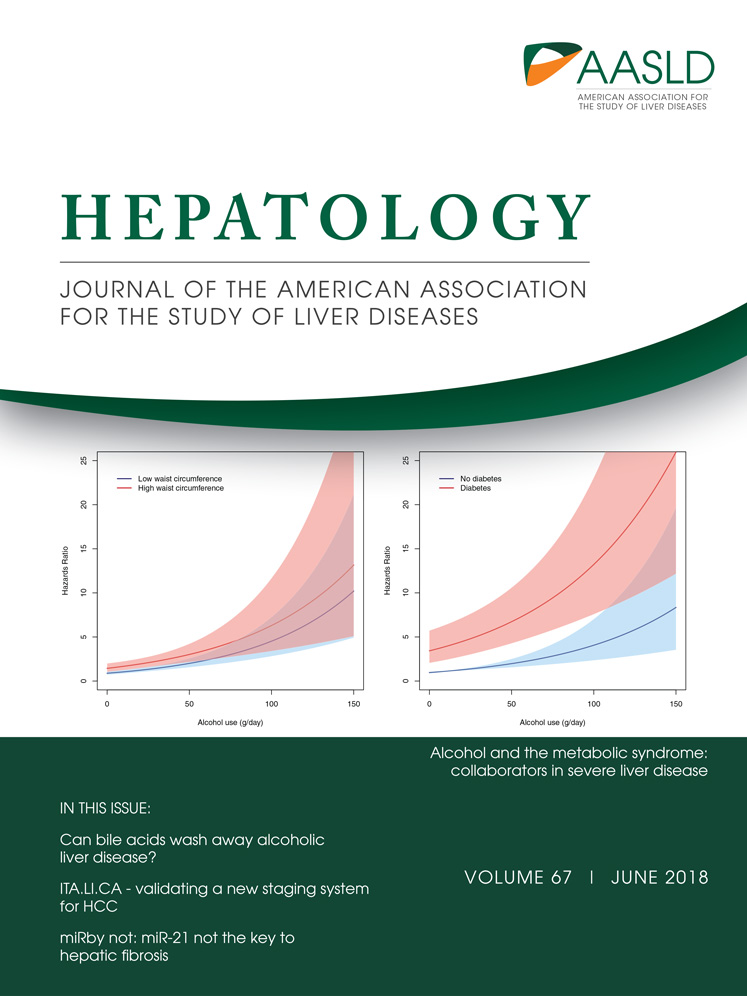People who survive an episode of severe alcoholic hepatitis should be advised to maintain total abstinence from alcohol
Potential conflict of interest: Nothing to report.
Supported by NIHR HTA grant 08/14/44; University College London (Impact PhD fellowship award MJW); Medical Research Council (UK) (grant no.: MR/M003132/1); and Imperial College BRC program.
We read with interest the article published in Hepatology by Louvet et al.1 highlighting factors influencing outcomes in people with severe alcoholic hepatitis. They found that beyond 6 months, alcohol relapse, defined as consumption of ≥30 g/day, was an independent predictor of mortality with a dose-related effect on the hazard ratio (HR). The effect of drinking behavior on outcome has also been examined in data collected in the Steroids and Pentoxyfylline for Severe Alcoholic Hepatitis (STOPAH) trial.2 Patients were classified, in the original published analysis, as abstinent or drinking. A return to alcohol consumption at day 90 was associated with a significantly higher mortality at day 450 than abstinence (HR, 2.77; 95% confidence interval [CI], 1.79-4.29; P < 0.00001).2 We have re-examined these data in an attempt to replicate the dose-dependent effect of drinking on mortality observed by Louvet et al.1
Participants enrolled in the STOPAH trial were treated for 28 days with prednisolone, pentoxifylline, both, or placebo.3 Patients categorized their drinking behavior at day 90 as: (1) abstinent or (2) drinking daily at low levels (men, ≤24 g; women, ≤16 g); (3) moderate levels (men, >24 but ≤60 g; women, >16 but ≤40 g); or (4) high levels (men, >60 g; women, >40 g). The association between drinking behavior and survival was examined using Cox proportional hazards regression analysis.
Data on drinking behavior were available in 397 patients; of these, 84 (9.7%) had died by day 450. A total of 138 (35%) had returned to drinking; the distribution within the three drinking categories was reasonably even. There was a clear dose-dependent increase in the HR as drinking levels increased viz: low, 2.09 (95% CI, 1.13-3.88; P = 0.02), moderate, 3.00 (95% CI, 1.69-5.35; P < 0.001) and high, 3.31 (95% CI, 1.86-5.90; P < 0.001) (Fig. 1).

Thus, while Louvet et al.1 found a dose-related effect of drinking on the HR for death above a threshold of 30g/day, we have shown that a return to drinking, at any level, confers a dose-related increase in the risk of death. Our use of sex-specific drinking thresholds, based on our previous finding that sex is an independent risk factor for mortality in people with severe alcoholic hepatitis who return to drinking,2 contrasts with the French group's use of a generic drinking threshold; this may explain the difference in our findings.
Although alcohol relapse has a significantly detrimental effect on outcome, people who survive an episode of severe alcoholic hepatitis and subsequently attain and maintain abstinence from alcohol still exhibit an appreciable mortality. We have shown previously that homozygosity for rs738409:G in PNPLA3 is an independent risk factor for medium-term mortality in this population.2 Both this genetic variant and sex should be added to the risk factors identified by Louvet et al. as determinants of outcome in people with severe alcoholic hepatitis.1
-
Stephen R. Atkinson1
-
Andrew McQuillin3
-
Marsha Y. Morgan2*
-
Mark R. Thursz1*
-
1Department of Hepatology
-
Division of Surgery and Cancer
-
Imperial College London
-
United Kingdom
-
2UCL Institute for Liver & Digestive Health
-
Division of Medicine
-
Royal Free Campus
-
University College London
-
London, United Kingdom
-
3Molecular Psychiatry Laboratory
-
Division of Psychiatry
-
University College London
-
London, United Kingdom




